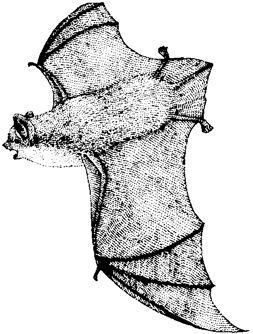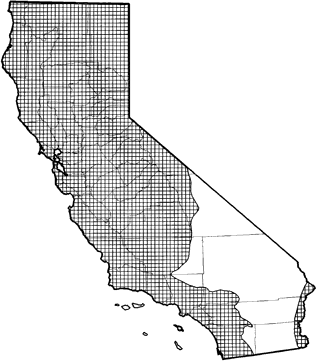
Yuma Myotis
Distribution, Abundance, and Seasonality
The Yuma myotis is common and widespread in California. It is uncommon in the Mojave and Colorado Desert regions, except for the mountain ranges bordering the Colorado River Valley. Found in a wide variety of habitats ranging from sea level to 3300 m (11,000 ft), but it is uncommon to rare above 2560 m (8000 ft). Optimal habitats are open forests and woodlands with sources of water over which to feed.

Range Map
Specific Habitat Requirements
Feeding: Feeds on a wide variety of small flying insects found by echolocation. This species usually feeds over water sources such as ponds, streams, and stock tanks. Prey includes moths, midges, flies, termites, ants, homopterans, and caddisflies (Easterla and Whitaker 1972, Black 1974, Whitaker et al. 1977, 1981). The Yuma myotis is an efficient forager, sometimes returning to the roost with a full stomach 15 min after dusk (Barbour and Davis 1969). These bats respond to temporary patches of prey, such as ant swarms (Vaughan 1980), although many authors report that regular foraging routes are followed.
Cover: Maternity colonies of several thousand females and young may be found in buildings, caves, mines, and under bridges. Warm, dark sites are preferred. Individuals are clustered tightly in the warmest sites when temperatures are low. If temperatures exceed 40ÁC, bats seek cooler locations, and individuals roost farther apart.
Reproduction: The Yuma myotis has a relatively poor urine concentrating ability, and frequently is observed drinking.
Water: Distribution is closely tied to bodies of water, which it uses as foraging sites and sources of drinking water. Open forests and woodlands are optimal habitat.
Pattern: Nocturnal. Hibernates. This species emerges soon after sunset in many areas (Barbour ansd Davis 1969), but Jones (1965) reported that peak activity was 1-2.5 hr after sunset. Warm temperatures are preferred, and activity may be extended on warm nights. Winter habits are poorly known, but this species apparently hibernates.
Species Life History
Activity Patterns: Probably makes local or short migrations to suitable hibernacula. Individuals that spend the summer at high elevations probably move downslope.
Seasonal Movements / Migration: No data found.
Home Range: Territoriality has not been reported. Probably not territorial at feeding or roosting sites; roosts in large groups.
Territory: The Yuma myotis, like other California bats, mates in the fall. Dalquest (1947) reported that the season of births lasted from late May to mid-June with a peak in early June. It is likely that some young are born in July in some areas. A single litter of 1 young is produced yearly. The species may live up to 8.8 years (Cockrum 1973).
Reproduction: The Yuma myotis may be found feeding and roosting with other bat species, such as Tadarida brasiliensis and Antrozous pallidus.
Niche: This species is difficult to distinguish from M. Iucifugus, with which it may occasionally hybridize (Harris 1974, Parkinson 1979).
Comments: This species is difficult to distinguish from M. Iucifugus, with which it may occasionally hybridize (Harris 1974, Parkinson 1979).
Sources & References
California Department of Fish and Game, 1999.
California's Wildlife, Sacramento, CA.
Written by: J. Harris, reviewed by: P. Brown, edited by: S. Granhom, R. Duke
Barbour, R. W., and W. H. Davis. 1969. Bats of America. Univ. of Kentucky Press, Lexington. 286pp. Black, H. L. 1974. A north temperate bat community: structure and prey populations. J. Mammal. 55:138-157. Cockrum, E. L. 1973. Additional longevity records for American bats. J. Ariz. Acad. Sci. 8:108-110. Dalquest, W. W. 1947. Notes on the natural history of the bat Corynorhinus rafinesquii in California. J. Mammal. 28:17-30. Easterla, D. A., and J. O. Whitaker, Jr. 1972. Food habits of some bats from Big Bend National Park, Texas. J. Mammal. 53:997-890. Findley, J. S., A. H. Harris, D. E. Wilson, and C. Jones. 1975. Mammals of New Mexico. Univ. New Mexico Press. Albuquerque. 360pp. Geluso, K. N. 1978. Urine concentrating ability and renal structure of insectivorous bats. J. Mammal. 59:312-323. Harris, A. H. 1974. Myotis yumanensis in interior southwestern North America, with comments on Myotis lucifugus. J. Mammal. 55:589-607. Jones, C. 1965. Ecological distribution and activity records of bats of the Mogollon Mountains area of New Mexico and adjacent Arizona. Tulane Studies Zool. 12:93-100. Licht, P., and P. Leitner. 1967. Behavioral responses to high temperatures in three species of California bats. J. Mammal. 48:52-61. Maser, C., B. R. Mate, J. F. Franklin, and C. T. Dyrness. 1981. Natural history of Oregon coast mammals. Pac. Northwest For. And Range Exp. Sta., USDA, For. Serv., Gen. Tech. Rep., PNW-133. 496pp. Parkinson, A. 1979. Morphologic variation and hybridizaton on Myotis yumanensis sociabilis and Myotis lucifugus carissima. J. Mammal. 60:489-504. Sumner, L., and J. S. Dixon. 1953. Birds and mammals of the Sierra Nevada. Univ. California Press, Berkeley. 484pp. Vaughan, T. A. 1980. Opportunistic feeding in two species of Myotis. J. Mammal. 61:118- 119. Whitaker, J. O., Jr., C. Maser, and L. E. Keller. 1977. Food habits of bats of western Oregon. Northwest Sci. 51:46-55. Whitaker, J. O., Jr., C. Maser, and S. P. Cross. 1981. Food habits of eastern Oregon bats, based on stomach and scat analyses. Northwest Sci. 55:281-292.
California Animal Facts | California's Wildlife